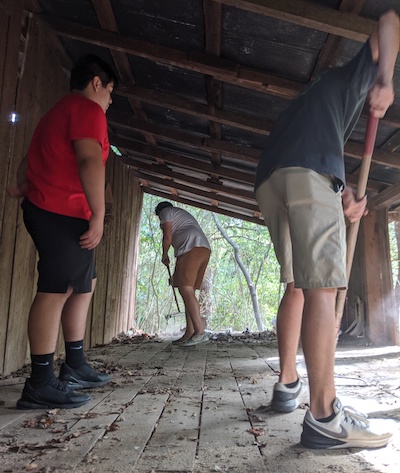A first-of-its-kind partnership between Hixson High School and the Tennessee Wildlife Resources Agency (TWRA) allows high school students to lead projects on nearly 80 acres of state-owned land.
Through the agreement, students participate in hands-on land management tasks, including conservation projects and trail clearing. In the process, students study agriculture and ecology, and learn to properly care for property and safely operate tools.
Initially, Hixson High needed more land for its growing agricultural program, so Principal Lee Sims reached out to state officials and TWRA, which owns hundreds of acres in the Chattanooga area, including 20 acres across the street. Eventually, a memorandum of understanding was signed, allowing students to manage the adjacent property and other nearby acres, and to participate in activities such as testing soil, identifying plants, studying insects, building walking trails, and creating outdoor classrooms for agricultural and science classes.
“It’s really been a win-win for us,” says Sims. “I’m seeing real relationships being built between the teachers and the students and between us and TWRA as well. Our community has been really pleased about how two government agencies have come together to help young people.”
Work outside the classroom
As land managers, Hixson High students are responsible for identifying trees, animals, pests and invasive species, says agricultural teacher Jeremy Kaylor. Students have also been renovating a barn that originally belonged to the Hixson family, so that history and engineering classes can study it, and they have cleared trails for physical education and science classes to use.
“It’s a living classroom,” says Kaylor.
Students go out to manage the land every Monday, Wednesday and Friday, weather permitting; they are in the classroom on the other days for lessons based on their experiences. The property is less than a 10-minute walk from the school, which is important to the partnership’s success since Hixson High has limited transportation funding. Students work about 40 minutes per session.
TWRA agents are spread thin, so students have some autonomy in regard to undertaking projects, says Kaylor. “We just make a phone call to TWRA and tell them what we’re doing; they say, ‘OK, sounds great,’” he says. “We get to work with them and work by ourselves. They get a lot of volunteer hours, and we get a lot of very hands-on experiences outside of the regular classroom.”
The academic pathway involved with the partnership was recently altered. Now, only a half-dozen students participate, but that number is expected to grow substantially over the next year as more students enter the pathway.
 “The numbers may not seem high, but these students probably do the work of 12 to 15 kids in one class period,” says Kaylor. “They’re all hands-on. They like a little bit of book work, but they all jump when they hear the word ‘outside.’”
“The numbers may not seem high, but these students probably do the work of 12 to 15 kids in one class period,” says Kaylor. “They’re all hands-on. They like a little bit of book work, but they all jump when they hear the word ‘outside.’”
Better CTE for students
The partnership has expanded what students and teachers can do in terms of postsecondary preparation, says John Maynard, career and technical education director for Hamilton County Schools, which includes Hixson High.
“What we’re doing at the district level is trying to create an atmosphere that encourages schools to develop these kinds of partnerships, including work-based learning opportunities with companies,” says Maynard. “That’s what we want our folks to be moving toward—realizing that CTE classes are better when they have partners than when they are by themselves.”


